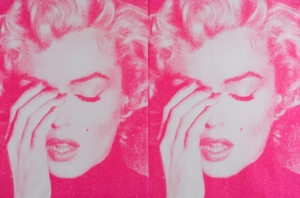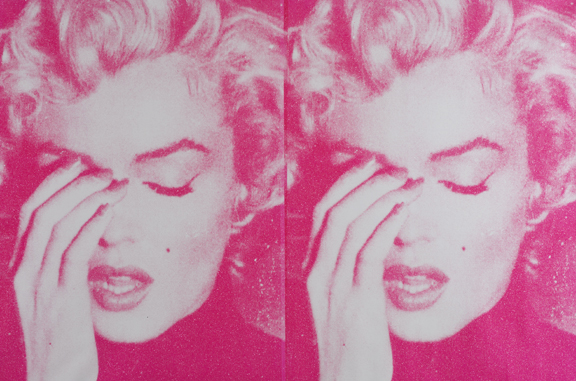Russell Young was always fascinated by America. He admittedly observes that it is far more common for Americans to wind up Anglophiles than vice versa, but Russell Young isn’t normal.

After a career photographing celebrities throughout England Young turned his focus towards creating a different form of art. Art that he kept to himself until his first exhibition in 2003.
Now, less than ten years later, Young has made a name for himself throughout the world as a young British artist working in a unique vein; melding screen printing, photography and the assertion of himself as artist into his occasional photographic appropriation.
At the retrospective of sorts the Goss-Michael Foundation currently on display throughout the gallery, Young’s critique of celebrity, which has characterized much of the work he created in his post-celebrity photographer phase, is glaringly evident.
The exhibit contains examples from several of his earliest series of paintings which include “Dirty Marilyn” from his Dirty Pretty Things series, images of Muhammad Ali and Jackie Kennedy from his American Envy series and “mug shots” of Elvis Presley and Sid Vicious.
Perhaps the easiest way to sort of define Young’s work, especially these early screen shots usually manipulated in some way; (his use of diamond dust is signature and in the case of the Vicious and Presley shots, the use of off-beat coloring), is as reaction to his career making celebrities look good.
Vicious, having just been brought in on the charge of murdering his wife looks like a killer, and Monroe, crying, is clearly immune to the country’s infatuation with her celebrity. Kurt Cobain is another image Young used in the Dirty Pretty Things series, a series perhaps intending to indicate the danger of the celebrity obsession and the lack of fulfillment found by the celebrities themselves.
Despite the “warnings” that seem to be implicit in these depictions of ours, and especially America’s obsession with the stars, Young remains a dedicated lover of America.
In 2010 Young endured a serious illness and was hospitalized for days as friends and family worried about his chances for recovery.
Post-illness, Young’s work, as will be obvious in the exhibition, took on a new form with political paintings such as “Helter Skelter” and Young’s use of the famous image of the Hell’s Angels at Altamont in 1969. Young called the event the “start and the fall of modern America” although his choice of image for his massive paintings in the series, seems to have taken place without significant reflection. Listening to Young speak, it seems as though his aesthetic notion of re-printing the photo over and over again onto the canvas, then proceeding to walk through, or crawl over the canvas with paint, is more integral to the finished product than the photo itself which is often unrecognizable. Although perhaps the aesthetic notion of distortion lends itself to a deeper critique of the incident inside the photo.
The exhibition includes one other notable series of paintings, the most recent set Young completed, entitled Only Anarchists are Pretty.
It’s almost as if these works were added as an afterthought, placed in the front room of the exhibition with no clear ties to the rest of Young’s work on display. To hear Young describe the rationale behind the large-scale canvases featuring photographs of women in various positions of bondage, is to hear the emotional rememberings of a childhood spent in the London council flats, the equivalent of the projects. Enduring beatings at the hands of schoolmates and living in what he equates to a feeling of entrapment even in his own home, led Young to create these images and name them for the projects themselves.
Perhaps the images are not as sexually indulgent as one might initially think, but even after the artist’s philosophy is revealed, the connection of nude women in various positions reminiscent of torture to a young boy in the London projects seems tenuous at best.
Despite a few moments of weakness, the Young show is valuable and will be especially appealing to anyone with even a passing interest in celebrity culture. His “anti-celebrity” paintings as he calls them, have certainly become more “beautiful and iconic” than he may have initially intended.
